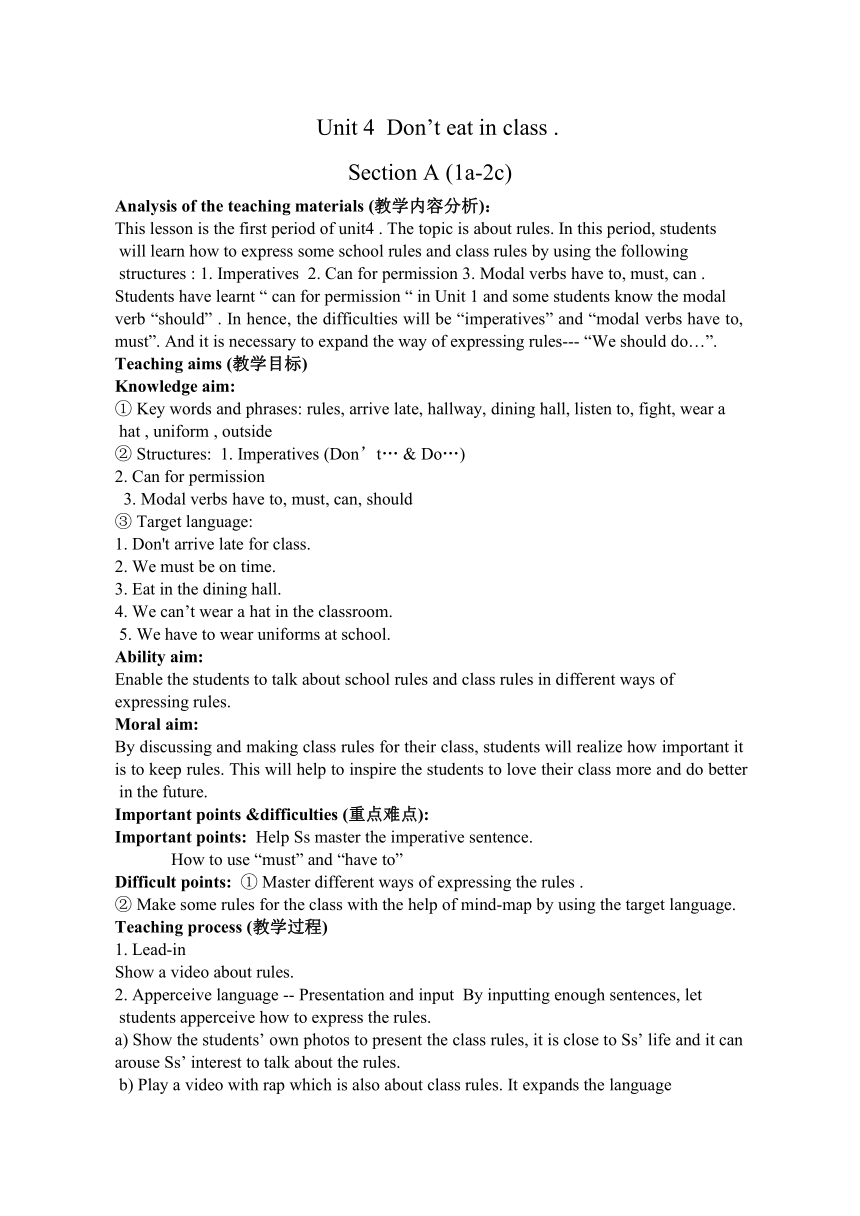新目标英语七年级下Unit 4 Don’t eat in class.Section A 1a-2c 教案(1课时)
文档属性
| 名称 | 新目标英语七年级下Unit 4 Don’t eat in class.Section A 1a-2c 教案(1课时) |  | |
| 格式 | zip | ||
| 文件大小 | 34.5KB | ||
| 资源类型 | 教案 | ||
| 版本资源 | 人教新目标(Go for it)版 | ||
| 科目 | 英语 | ||
| 更新时间 | 2019-10-17 16:20:04 | ||
图片预览

文档简介
Unit?4??Don’t?eat?in?class?.
Section?A?(1a-2c)
Analysis?of?the?teaching?materials?(教学内容分析):?
This?lesson?is?the?first?period?of?unit4?.?The?topic?is?about?rules.?In?this?period,?students
?will?learn?how?to?express?some?school?rules?and?class?rules?by?using?the?following
?structures?:?1.?Imperatives??2.?Can for?permission?3.?Modal?verbs?have?to,?must,?can?.?
Students?have?learnt?“?can?for?permission?“?in?Unit?1?and?some?students?know?the?modal?
verb?“should”?.?In?hence,?the?difficulties?will?be?“imperatives”?and?“modal?verbs?have?to,?must”.?And?it?is?necessary?to?expand?the?way?of?expressing?rules---?“We?should?do…”.??
Teaching?aims?(教学目标)??
Knowledge?aim:??
①?Key?words?and?phrases:?rules,?arrive?late,?hallway,?dining?hall,?listen?to,?fight,?wear?a
?hat?,?uniform?,?outside??
②?Structures:??1.?Imperatives?(Don’t…?&?Do…)??
2.?Can?for?permission???
??3.?Modal?verbs?have?to,?must,?can,?should???
③?Target?language:?
1.?Don't?arrive?late?for?class.??
2.?We?must?be?on?time.???
3.?Eat?in?the?dining?hall.?????
4.?We?can’t?wear?a?hat?in?the?classroom.?
?5.?We?have?to?wear?uniforms?at?school.?
Ability?aim:?
Enable?the?students?to?talk?about?school?rules?and?class?rules?in?different?ways?of?
expressing?rules.?
Moral?aim:?
By?discussing?and?making?class?rules?for?their?class,?students?will?realize?how?important?it?is?to?keep?rules.?This?will?help?to?inspire?the?students?to?love?their?class?more?and?do?better?in?the?future.???
Important?points?&difficulties?(重点难点):?
Important?points:??Help?Ss?master?the?imperative?sentence.?
?????????????How?to?use?“must”?and?“have?to”?
Difficult?points:??①?Master?different?ways?of?expressing?the?rules?.??
②?Make?some?rules?for?the?class?with?the?help?of?mind-map?by?using?the?target?language.?
Teaching?process?(教学过程)
1.?Lead-in?
Show a video about rules.?
2.?Apperceive?language?--?Presentation?and?input??By?inputting?enough?sentences,?let
?students?apperceive?how?to?express?the?rules.?
a)?Show?the?students’?own?photos?to?present?the?class?rules,?it?is?close?to?Ss’?life?and?it?can?arouse?Ss’?interest?to?talk?about?the?rules.
?b)?Play?a?video?with?rap?which?is?also?about?class?rules.?It?expands?the?language?
knowledge?and?stirs?the?enthusiasm?of?students’?learning.?
3.Drilling?and?practice??
To?mobilize?the?initiative?of?students’?learning?and?reflect?the?practicability?of?language?,
?let?students?play?a?game?called?“quick?response”?and?act?the?scene?plays?to?practice?the
?target?language,?instead?of?only?pair?work?.?
4.?Listening??
To?train?students'?ability?of?listening,?ask?students?to?do?listening?exercises?1b?and?2b?on
?text?books.?Present?another?two?ways?of?expressing?rues—“We?can’t?do…”and?“We?
should?do?…?
5.?Find?out?the?rules?
Make?a?conclusion?about?ways?of?expressing?rules??To?exert?the?initiative?of?students'?
autonomous?learning?and?develop?students'?thinking?ability?,?let?students?discuss?“How?to?express?the?rules”,?then?finish?the?mind-map?named?tree-map.?The?tree-map?not?only?
visualizes?the?language?knowledge?but?also?induces?aesthetic?feeling,?which?impresses?
students?deeply.
?6.?Use?language?
Output?the?target?language???Language?comes?from?life?and?is?used?in?life?.?So?I?contact?
campus?life?and?plan?these?activities.?Imagine?there?will?be?a?Advanced?Class?Campaign?in?our?school?next?month.?Ask?students?to?prepare?for?it.
?First,?discuss?and?make?class?rules?and?the?slogan?of?their?class?to?make?their?class?be
?better.
?Then,?finish?the?speech?draft.?
Next,?the?teacher?shows?some?students’?writing.?
Finally,?ask?students?to?give?speeches?to?win?the?Advanced?Class.?
7.?Make?a?conclusion??
Make?a?conclusion?of?this?lesson?by?presenting?a?mind-map?which?visualizes?the?language?knowledge?clearly?.
8.?Homework??Ask?students?to?make?a?mind-map?of?this?lesson?instead?of?doing?some?exercises.?This?homework?can?make?students?review?what?they?have?learnt?well.?Meanwhile,?it?develops?students'?abilities?of?thinking.?
我的教学设计思路:?
本节课学习的内容为班规和校规,为充分调动学生学习的积极性,将全班分为4个组,为后面Task6、Task7和Task8学习环节做了铺垫。具体设计思路如下:?
1.?引入课题:通过一段英文短片来引入课题rule。
2.感知语言---语言的呈现和输入:通过一定量的语言呈现和输入让学生充分感知如何表达班规和校规。a)用本班部分学生违反班规的照片来逐步呈现本节课的目标语言,这种方式贴近学生生活,能很快激起学生的学习兴趣。
b)通过播放一段学生们喜爱的rap形式的视频来呈现其他一些班规的表达,有效地拓展了语言知识,并使学生保持学习班规的热情。
3.目标语言的操练:为调动每一位学生的积极性,并体现目标语言的实用性,突破了以往简单的pair?work操练方式,设计了“快速反应游戏”和“情景小剧表演”两个活动。
4.听力训练:播放课本的两个听力练习,训练学生的听力能力同时从课本听力材料中提取?“We?can’t?do?”,拓展“?We?should?do?”这两种表达rules?的方式。
5.总结发现语言的规律---总结rules的表达方式?:为了充分发挥学生自主学习的能动性,培养学生的思维能力,让学生先小组讨论,再自行归纳总结。并完成学生学案中的思维导图。该思维导图为树状图(Tree-map),这不仅使归纳出的知识内容形象化,而且具有一定的美感,从而让学生对所学内容印象深刻。
6.运用所学语言---目标语言的输出:语言来源于生活,运用于生活。联系校园生活设计了以下活动:假设下个月学校将进行“校先进班级”评选,让学生先通过讨论为自己的班级制定一些班规来让班级变得更好,然后完成演讲稿上的写作内容,再全班分享。最后,演练竞选“校先进班级”的竞选演讲。
7.课堂总结:用一张思维导图归纳和总结本节课的内容,形象而又清晰明了。
8.家庭作业:让学生对本节课所学的内容制作一张思维导图而不是传统的做练习的作业模式。这能让学生既有效地复习和巩固了所学知识,也训练了思维能力。?
Section?A?(1a-2c)
Analysis?of?the?teaching?materials?(教学内容分析):?
This?lesson?is?the?first?period?of?unit4?.?The?topic?is?about?rules.?In?this?period,?students
?will?learn?how?to?express?some?school?rules?and?class?rules?by?using?the?following
?structures?:?1.?Imperatives??2.?Can for?permission?3.?Modal?verbs?have?to,?must,?can?.?
Students?have?learnt?“?can?for?permission?“?in?Unit?1?and?some?students?know?the?modal?
verb?“should”?.?In?hence,?the?difficulties?will?be?“imperatives”?and?“modal?verbs?have?to,?must”.?And?it?is?necessary?to?expand?the?way?of?expressing?rules---?“We?should?do…”.??
Teaching?aims?(教学目标)??
Knowledge?aim:??
①?Key?words?and?phrases:?rules,?arrive?late,?hallway,?dining?hall,?listen?to,?fight,?wear?a
?hat?,?uniform?,?outside??
②?Structures:??1.?Imperatives?(Don’t…?&?Do…)??
2.?Can?for?permission???
??3.?Modal?verbs?have?to,?must,?can,?should???
③?Target?language:?
1.?Don't?arrive?late?for?class.??
2.?We?must?be?on?time.???
3.?Eat?in?the?dining?hall.?????
4.?We?can’t?wear?a?hat?in?the?classroom.?
?5.?We?have?to?wear?uniforms?at?school.?
Ability?aim:?
Enable?the?students?to?talk?about?school?rules?and?class?rules?in?different?ways?of?
expressing?rules.?
Moral?aim:?
By?discussing?and?making?class?rules?for?their?class,?students?will?realize?how?important?it?is?to?keep?rules.?This?will?help?to?inspire?the?students?to?love?their?class?more?and?do?better?in?the?future.???
Important?points?&difficulties?(重点难点):?
Important?points:??Help?Ss?master?the?imperative?sentence.?
?????????????How?to?use?“must”?and?“have?to”?
Difficult?points:??①?Master?different?ways?of?expressing?the?rules?.??
②?Make?some?rules?for?the?class?with?the?help?of?mind-map?by?using?the?target?language.?
Teaching?process?(教学过程)
1.?Lead-in?
Show a video about rules.?
2.?Apperceive?language?--?Presentation?and?input??By?inputting?enough?sentences,?let
?students?apperceive?how?to?express?the?rules.?
a)?Show?the?students’?own?photos?to?present?the?class?rules,?it?is?close?to?Ss’?life?and?it?can?arouse?Ss’?interest?to?talk?about?the?rules.
?b)?Play?a?video?with?rap?which?is?also?about?class?rules.?It?expands?the?language?
knowledge?and?stirs?the?enthusiasm?of?students’?learning.?
3.Drilling?and?practice??
To?mobilize?the?initiative?of?students’?learning?and?reflect?the?practicability?of?language?,
?let?students?play?a?game?called?“quick?response”?and?act?the?scene?plays?to?practice?the
?target?language,?instead?of?only?pair?work?.?
4.?Listening??
To?train?students'?ability?of?listening,?ask?students?to?do?listening?exercises?1b?and?2b?on
?text?books.?Present?another?two?ways?of?expressing?rues—“We?can’t?do…”and?“We?
should?do?…?
5.?Find?out?the?rules?
Make?a?conclusion?about?ways?of?expressing?rules??To?exert?the?initiative?of?students'?
autonomous?learning?and?develop?students'?thinking?ability?,?let?students?discuss?“How?to?express?the?rules”,?then?finish?the?mind-map?named?tree-map.?The?tree-map?not?only?
visualizes?the?language?knowledge?but?also?induces?aesthetic?feeling,?which?impresses?
students?deeply.
?6.?Use?language?
Output?the?target?language???Language?comes?from?life?and?is?used?in?life?.?So?I?contact?
campus?life?and?plan?these?activities.?Imagine?there?will?be?a?Advanced?Class?Campaign?in?our?school?next?month.?Ask?students?to?prepare?for?it.
?First,?discuss?and?make?class?rules?and?the?slogan?of?their?class?to?make?their?class?be
?better.
?Then,?finish?the?speech?draft.?
Next,?the?teacher?shows?some?students’?writing.?
Finally,?ask?students?to?give?speeches?to?win?the?Advanced?Class.?
7.?Make?a?conclusion??
Make?a?conclusion?of?this?lesson?by?presenting?a?mind-map?which?visualizes?the?language?knowledge?clearly?.
8.?Homework??Ask?students?to?make?a?mind-map?of?this?lesson?instead?of?doing?some?exercises.?This?homework?can?make?students?review?what?they?have?learnt?well.?Meanwhile,?it?develops?students'?abilities?of?thinking.?
我的教学设计思路:?
本节课学习的内容为班规和校规,为充分调动学生学习的积极性,将全班分为4个组,为后面Task6、Task7和Task8学习环节做了铺垫。具体设计思路如下:?
1.?引入课题:通过一段英文短片来引入课题rule。
2.感知语言---语言的呈现和输入:通过一定量的语言呈现和输入让学生充分感知如何表达班规和校规。a)用本班部分学生违反班规的照片来逐步呈现本节课的目标语言,这种方式贴近学生生活,能很快激起学生的学习兴趣。
b)通过播放一段学生们喜爱的rap形式的视频来呈现其他一些班规的表达,有效地拓展了语言知识,并使学生保持学习班规的热情。
3.目标语言的操练:为调动每一位学生的积极性,并体现目标语言的实用性,突破了以往简单的pair?work操练方式,设计了“快速反应游戏”和“情景小剧表演”两个活动。
4.听力训练:播放课本的两个听力练习,训练学生的听力能力同时从课本听力材料中提取?“We?can’t?do?”,拓展“?We?should?do?”这两种表达rules?的方式。
5.总结发现语言的规律---总结rules的表达方式?:为了充分发挥学生自主学习的能动性,培养学生的思维能力,让学生先小组讨论,再自行归纳总结。并完成学生学案中的思维导图。该思维导图为树状图(Tree-map),这不仅使归纳出的知识内容形象化,而且具有一定的美感,从而让学生对所学内容印象深刻。
6.运用所学语言---目标语言的输出:语言来源于生活,运用于生活。联系校园生活设计了以下活动:假设下个月学校将进行“校先进班级”评选,让学生先通过讨论为自己的班级制定一些班规来让班级变得更好,然后完成演讲稿上的写作内容,再全班分享。最后,演练竞选“校先进班级”的竞选演讲。
7.课堂总结:用一张思维导图归纳和总结本节课的内容,形象而又清晰明了。
8.家庭作业:让学生对本节课所学的内容制作一张思维导图而不是传统的做练习的作业模式。这能让学生既有效地复习和巩固了所学知识,也训练了思维能力。?
同课章节目录
- Unit 1 Can you play the guitar?
- Section A
- Section B
- Unit 2 What time do you go to school?
- Section A
- Section B
- Unit 3 How do you get to school?
- Section A
- Section B
- Unit 4 Don't eat in class.
- Section A
- Section B
- Unit 5 Why do you like pandas?
- Section A
- Section B
- Unit 6 I'm watching TV.
- Section A
- Section B
- Review of Units 1-6
- Unit 7 It's raining!
- Section A
- Section B
- Unit 8 Is there a post office near here?
- Section A
- Section B
- Unit 9 What does he look like?
- Section A
- Section B
- Unit 10 I'd like some noodles.
- Section A
- Section B
- Unit 11 How was your school trip?
- Section A
- Section B
- Unit 12 What did you do last weekend?
- Section A
- Section B
